Day 1 of a long weekend of Spring Migration tours today. As this looked like it might be the best day, weather-wise, we started with a walk out to Burnham Overy Dunes.
A Common Whitethroat was singing from the hedge by the main road where we parked and as we walked down along the lane a second was singing from deep in the hedge. They have been thin on the ground here until now, so these were presumably fairly recent arrivals. A couple of Skylarks were singing overhead and a Chiffchaff was demonstrating how it got its name – it really sounded like spring, even if it was a bit cold in the NE wind.
Our first Lesser Whitethroat was rattling from a rather distant hedge, but a little further along one was singing in the blackthorn right by the track. It proceeded to fly back and forth across the path a couple of times, and then very helpfully landed up in a small hawthorn in full view in front of us. Lovely views of this usually rather shy warbler. There were lots of Sedge Warblers singing on either side of us on the walk out. Most were tucked down out of the breeze, but eventually we found one perched in a bramble clump. We all had great views of it through the scope, but typically it flew down out of sight just as we got round to trying to get a photo! A Willow Warbler zipped past us along the track, heading back inland. Presumably a recently arrived migrant on its way.
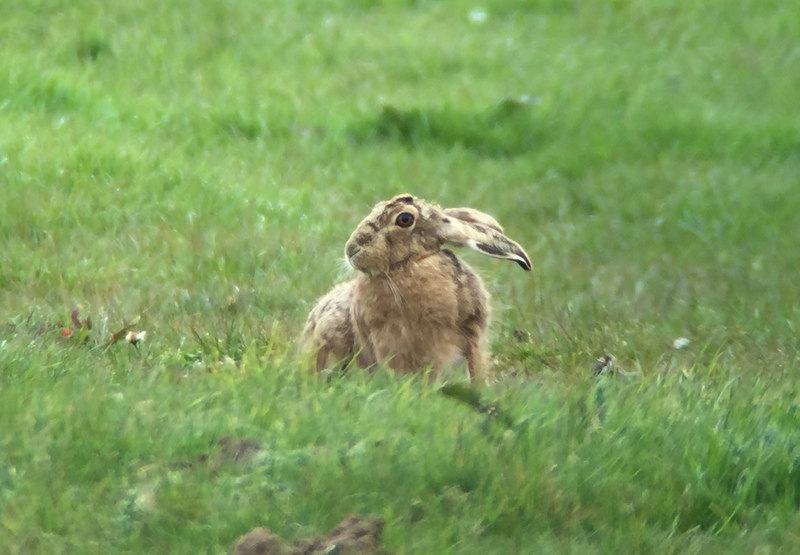 Brown Hare – a couple were out on the grazing meadows
Brown Hare – a couple were out on the grazing meadows
We found one Brown Hare hunkered down in the middle of the grazing meadows. We had just had a good look at it through the scope, when one of the group spotted a second Hare a bit closer and out in the open on the other side. One of the wardens was just walking round the marshes further back, so had probably just disturbed it.
There were plenty of Egyptian Geese and Greylags out on the grass today. Three Brent Geese obviously preferred being on here to out on the saltmarsh. But there was no sign of any Pink-footed Geese today, nor the drake Wigeon which has been here recently – perhaps the warden had flushed them on his rounds.
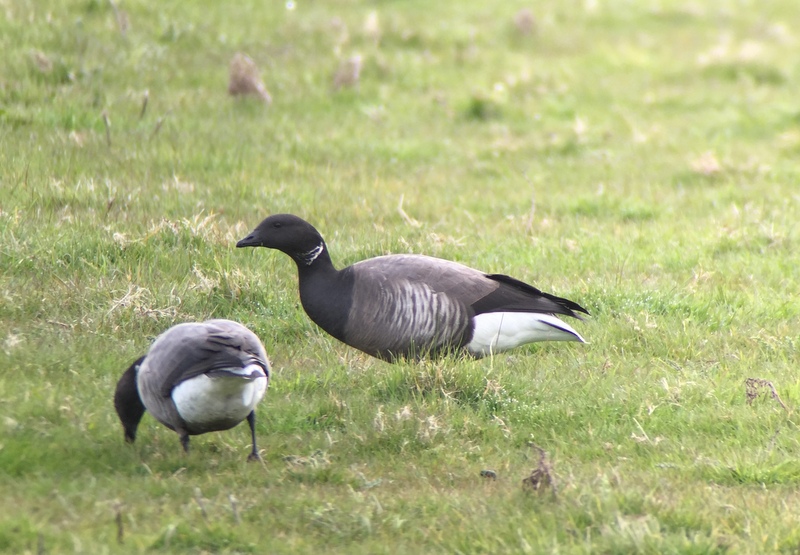 Brent Geese – three were still favouring the grazing marshes
Brent Geese – three were still favouring the grazing marshes
We could see a nice pair of Gadwall, two or three Teal asleep in the grass by a pool and a few Tufted Duck. A Common Pochard flew over. A Little Grebe was laughing maniacally from the ditch below us, but two out on one of the reedy pools were easier to see.
At that point, we looked up to see a Spoonbill flying in from the direction of the harbour. It had a stick in its spoon-shaped bill, presumably nest material, which it was carrying back to the colony.
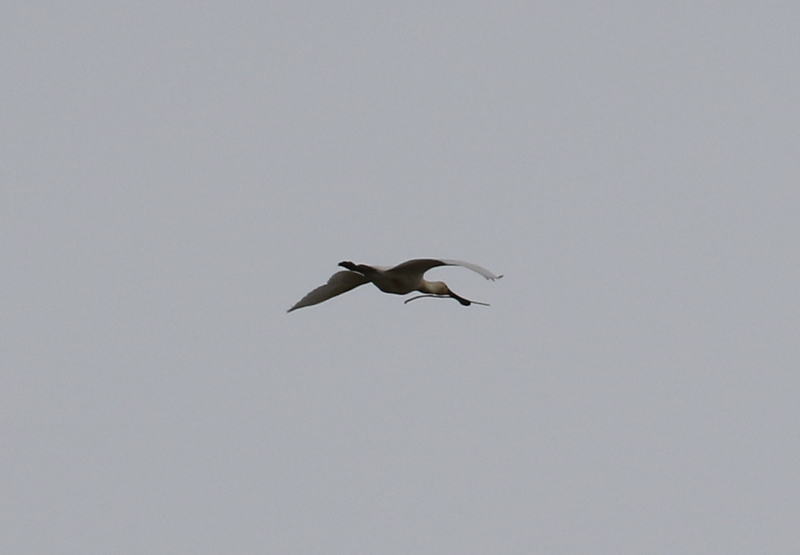 Spoonbill – flying back with nest material
Spoonbill – flying back with nest material
Out on the grazing marshes, we could also see numerous Lapwing, Redshanks and Oystercatchers. Three Avocets were also on one of the pools. Three Ruff flew past over the track. A couple of the Lapwings started displaying, tumbling acrobatically in the air. The Redshanks and Oystercatchers were very vocal too – their breeding season is here. When a Marsh Harrier and a Grey Heron both flew over at the same time, the birds responded by trying to chase them off, the Heron distracting most of the attention from the Harrier.
There were more waders out in the harbour, once we got up onto the seawall. A small group of Black-tailed Godwits were mostly in bright orange breeding plumage. In contrast, of the three Grey Plover we could see, only one was just starting to show a little black on the belly. We heard a Whimbrel calling and could see it heading our way over the saltmarsh. Thankfully it then landed down with the other waders right in front of us, where we could see its stripy head and next to a Black-tailed Godwit, the two were rather similar in size.
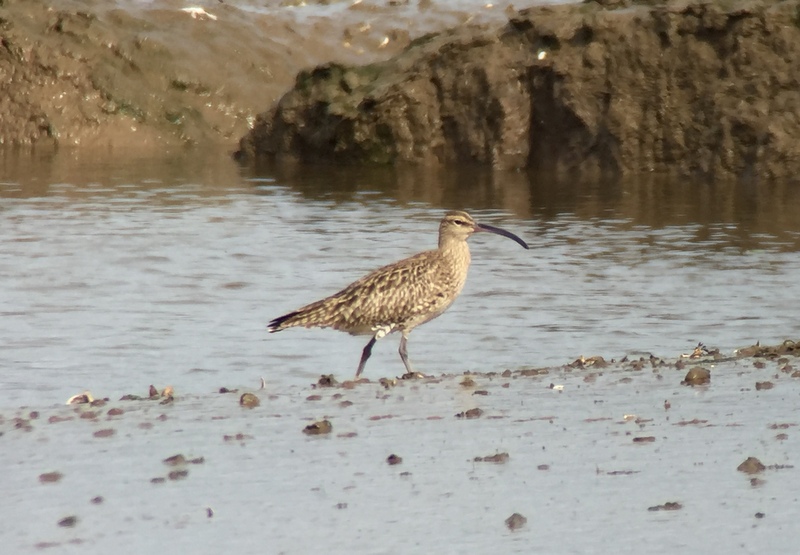 Whimbrel – flew in to join the other waders in the harbour
Whimbrel – flew in to join the other waders in the harbour
The reedbed was rather quiet. The wind was whistling through the reeds today. We did get one burst of booming from the resident Bittern, but generally it seemed a little reluctant to perform today.
There were more Brent Geese out on the saltmarsh further along. A careful scan produced one that was a little darker than the rest, with a more obvious white flank patch and collar. This is the Black Brant x Dark-bellied Brent hybrid, which returns here every winter with our regular Russian Dark-bellied Brent Geese. Many of the Brent Geese which were here through the winter have already left, and it won’t be long now before most of these last flocks depart for Russia too.
There were lots of Linnets in the Suaeda bushes by the path and a smart Redshank perched up on a post for us to give it some admiring looks.
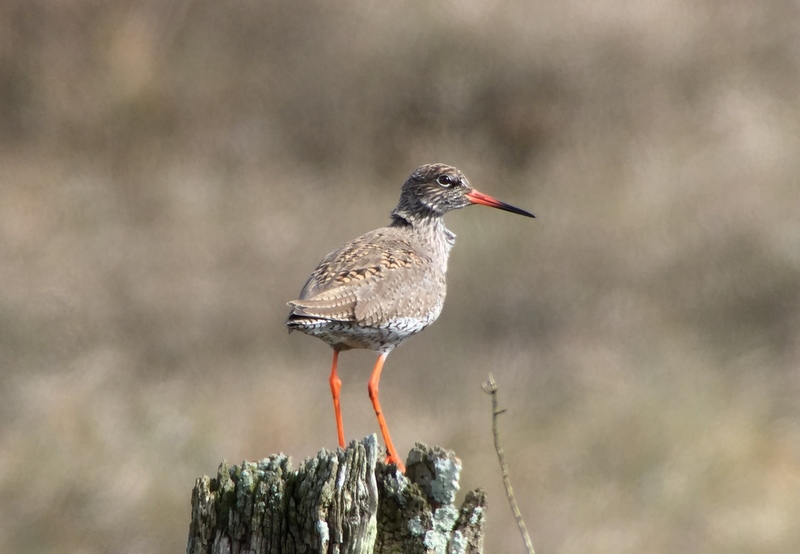 Redshank – perched nicely for us on a post
Redshank – perched nicely for us on a post
When we got to the dunes, we turned east. It was nice to get some shelter from the wind, but there were not many birds at first. Then we started to encounter a few Meadow Pipits and then increasingly large flocks of Linnets. We looked up to see two Red Kites circling lazily over the back of the dunes. A couple of Swallows were on the move, heading west. In their favoured dune slack, we only managed to find one Wheatear today, a female, but at least that was a start.
There was no sign of the Ring Ouzels today in the bushes they have been favouring recently, but as we walked a little further over the dunes we eventually spotted one in a bush distantly the other side of the fence. We got it in the scope and had a quick look, in case it flew off. A second Ring Ouzel appeared on the grass next to it briefly.
We made our way over the dunes to try to get a bit closer, and had just got the scope onto one Ring Ouzel on the grass when it flew further back into the bushes out of sight. The warden then appeared from round the other side! We positioned ourselves in the dunes so that we would see them if they dropped back out onto the grass to feed, but the next thing we knew they took off and flew out over the dunes calling, three of them. We had great views of them as the Ring Ouzels flew over us.
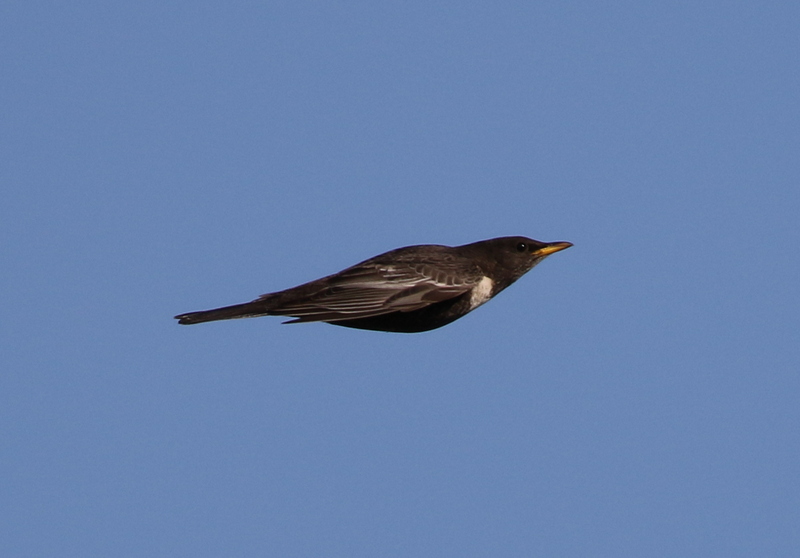 Ring Ouzel – one in flight from here last week
Ring Ouzel – one in flight from here last week
Even better, a few minutes later a fourth Ring Ouzel flew out too and this one landed right in the top of a bush in the dunes. A smart male, with a bold white gorget across his breast, he sat in full view for some time, allowing us to get a great look at him.
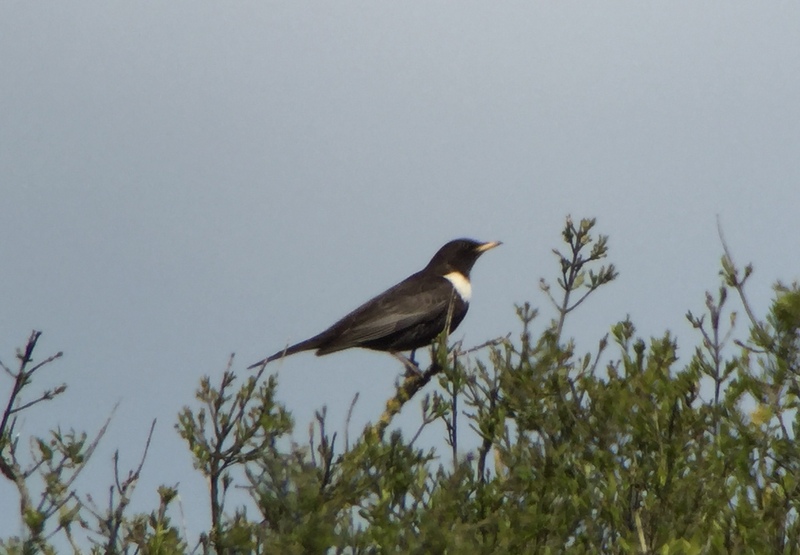 Ring Ouzel – this make perched up for us in a bush
Ring Ouzel – this make perched up for us in a bush
While we had a rest in the dunes, we scanned across the pools and marshes in front of us to see what we could see. A very distant white blob perched in a tree turned out to be a Spoonbill. It was a bit hazy, but we could make out its bushy nuchal crest blowing in the breeze. Then another big white bird appeared from out of a ditch and flew across towards the same trees. When it landed again, we could confirm that it was the Great White Egret – we could see its large size and long neck. When two Greylags nearly dropped down on it, it flew again and landed in a dead tree nearby.
The walk back through the dunes did not produce anything else of note, but from back up on the seawall a scan of the grazing marshes produced another two Wheatears on the grass, this time including a smart male sporting a black bandit mask. Four more Whimbrel flew over the grazing marsh calling. And one of the singing Sedge Warblers finally performed for the camera, perched out on a long aerial bramble stem, even though it was getting blown all over the place in the wind.
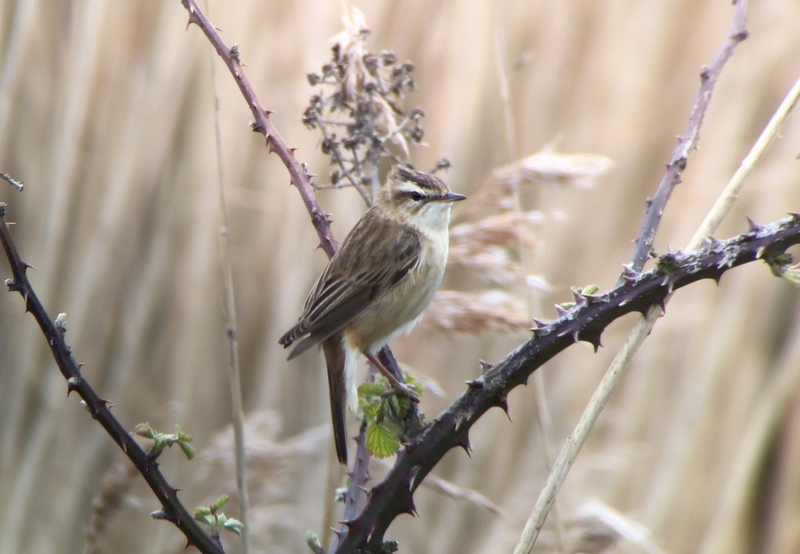 Sedge Warbler – lots are in and singing now
Sedge Warbler – lots are in and singing now
We were almost back across the grazing marshes when we noticed two more Spoonbills, circling over the trees way off to the east. They turned towards us and we waited for them to come our way. They took remarkably little time to reach us, with the benefit of a strong tail wind, and headed swiftly out towards the harbour.
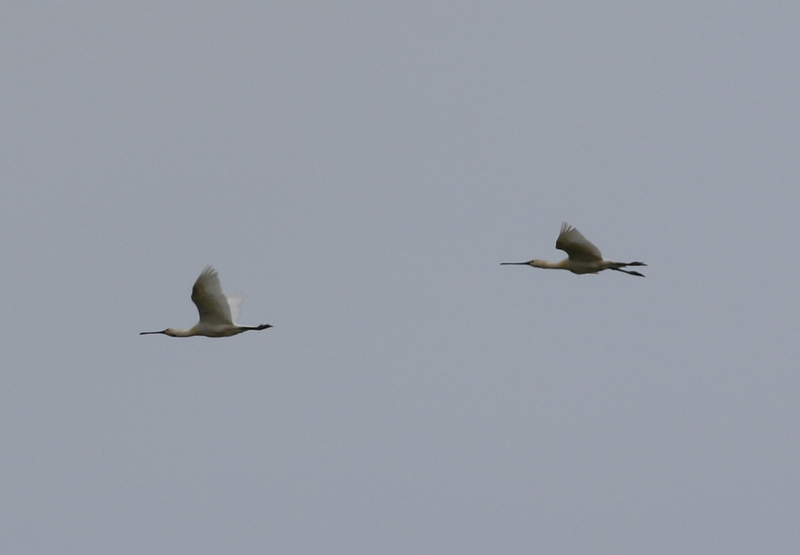 Spoonbill – these two were heading out towards the harbour
Spoonbill – these two were heading out towards the harbour
We had lunch back at Holkham, in a slightly more sheltered spot. Several Swallows and House Martins were hawking for insects over the trees. A Sparrowhawk circled up distantly. Then, after lunch, we made our way east to Stiffkey Fen.
A pair of Marsh Harriers were circling over the valley, the smart grey-winged male above and the darker brown female below. He made a couple of playful stoops at her, and she turned upside down and they talon-grappled at one point, all part of the courtship display, before dropping down into the reeds.
A lone Stock Dove was in the weedy field by the path and its iridescent green neck patch shone in the afternoon sunshine. A Lesser Whitethroat was singing in the hedge and a Common Whitethroat was doing the same across the road. As we walked down alongside the river, a couple of Bullfinches were piping from the sallows ahead of us, but were hard to see until they flew. A Cetti’s Warbler shouted at us from the brambles and a Willow Warbler sang from the trees. Several Swallows, a couple of House Martins and a Sand Martin were hawking for insects over the water.
From up on the seawall, we could see a smart summer-plumaged Black-tailed Godwit down in the harbour channel beyond. There was also a large group of Black-tailed Godwits roosting on the Fen, with a few still in their duller grey-brown non-breeding plumage. In between the legs of the Godwits, we spotted a single Knot, much smaller by comparison, shorter billed, and still in its grey winter plumage. Further over, on one of the islands at the back of the Fen, two Little Ringed Plovers were chasing each other round on the mud.
 Black-tailed Godwit – there were still lots at Stiffkey Fen today
Black-tailed Godwit – there were still lots at Stiffkey Fen today
We walked on, round towards the harbour. A lovely male Marsh Harrier with silvery grey wings looked a picture quartering along the edge of a bright-yellow oilseed rape field. A Whimbrel flew across the channel and started probing in the muddy bank along one side. An Orange Tip butterfly in the shelter of the bank stopped to feed on a dandelion flower in the sunshine.
 Orange Tip – out in the sunshine
Orange Tip – out in the sunshine
Looking out across the harbour, we could see lots of Sandwich Terns shimmering in the heat haze. It was only when they were spooked by something later and flew up into the sky that we could see them clearly. The tide was still out, so there were not many waders in view and those we could see were rather distant. Still, we managed to find a Ringed Plover for the day’s list and while we were watching it a cracking summer-plumage male Bar-tailed Godwit, with deep rusty underparts extending right down under the tail, walked past.
After enjoying the sunshine for a few minutes while we scanned the harbour, we turned to head back. Along the edge of the reeds at the Fen, a Common Snipe had appeared. It was very well camouflaged and tricky to see at first against the similarly coloured reed stems, but easier through the scope.
We still had time for one last stop, so we headed for the local gull colony. There are normally Mediterranean Gulls at Stiffkey Fen, but we hadn’t seen any today, so this gave us another chance to catch up with the species. Sure enough, out amongst the hordes of noisy Black-headed Gulls, we spotted a much darker jet black head (Black-headed Gulls have dark chocolate brown heads!). A cracking adult Mediterranean Gull, we could also see its heavier, brighter red bill and we noted the way the black hood extends further down the back of the neck. Out on the edge of the colony we could also see a pair of white-headed Common Gulls.
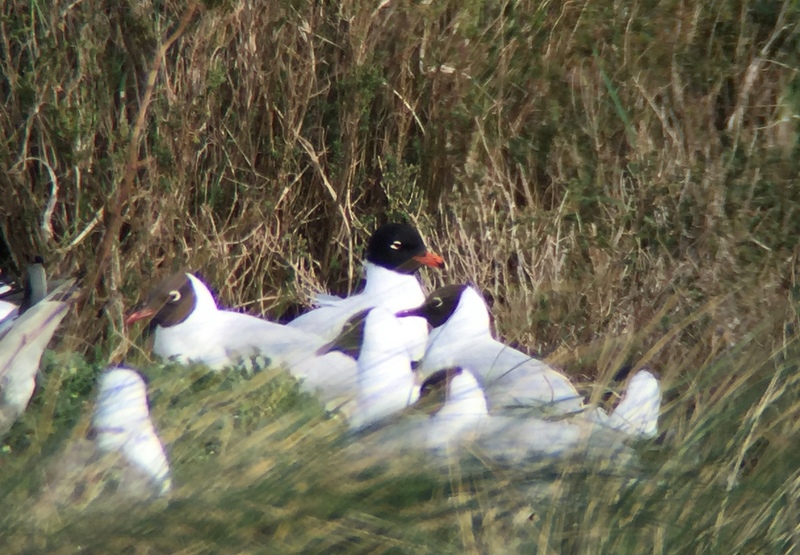 Mediterranean Gull – in with lots of Black-headed Gulls
Mediterranean Gull – in with lots of Black-headed Gulls
A quick look at the waders out in the harbour produced a good number of Turnstone in with the Oystercatchers and a couple of Curlew. A female Wigeon roosting on the edge of a sandbar was a bit of a surprise. Further out, several Common Seals were hauled out in the shallows on the edge of the main channel. Then it was time to head for home.
















